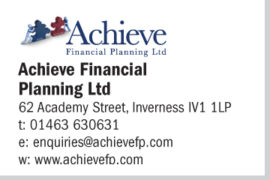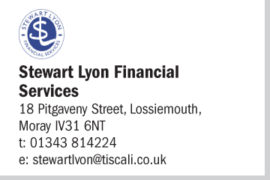INDEPENDENT FINANCIAL ADVICE ON MONEY MATTERS AROUND THE HIGHLANDS, ISLANDS & MORAY

If you have any existing investment plans or are considering making new investments, you should be aware of the phrase attitude to risk. This is one of the key principles in investing and one that should be reviewed regularly so that your investments and your objectives are aligned.
What do we mean by attitude to risk? How is it calculated? And why is it so important?
In the context of the work that we do as Independent Financial Advisers, we must consider a broad range of risks that can have an impact on your future returns. When discussing attitude to risk, we are specifically looking at your attitude to investment risk, which is completely personal to you. It is calculated by considering your views on a range of outcomes which then determine what level of risk you feel comfortable with.
What we are trying to ascertain is how much risk you are prepared to take with your assets over a particular timeframe.
This can be influenced by many factors including your own personal situation, your age, your health and the current economic climate.
You can also have different attitudes towards specific goals. For example, saving money towards a deposit to buy your first home would generally be kept in something accessible and safe with very little exposure to investment risk. A longer-term pension investment with many years to retirement could be invested into something with a higher risk element to try and make a higher return over the medium to long term. There is no correct outcome when looking at risk profiles. What is right for you may not be the same for a relative, or friend or colleague, as their circumstances and timescales and views will likely differ to your own.
In addition to understanding attitude to risk we also need to assess your capacity for loss. With attitude to risk we are dealing with your mindset – your feelings and beliefs. Capacity for loss is a more scientific approach. It looks at the real-life numbers of an individual’s financial situation and tries to quantify what the impact would be on the standard of living if things don’t go to plan. With investments we always need to accept that markets are imperfect. Quite often we are going to see inconsistencies in returns that can have a negative impact on your investments over any given period. If we can set out expectations and look at probable returns or potential losses before establishing investments, then we have set the boundaries comprehensively at the beginning.
A professional adviser will take time to understand your objectives clearly and assess the variables that will influence a particular investment decision. This is conducted through an attitude to risk questionnaire and a detailed fact find to quantify the capacity for loss. Ultimately where we are trying to arrive, is to be able to match your individual views, opinions and financial situation to a range of investments that will make returns in line with your expectations but not fall below a level which would affect your standard of living.
In practice, clarifying attitude to risk and capacity for loss is quite detailed. If you want to learn more about the different risk profiles and corresponding funds, further guidance can be provided by any of the independent
Get Expert Help
Advanced Investment & Retirement Planning Ltd is an appointed representative of 2plan wealth management Ltd. It is authorised and regulated by the Financial Conduct Authority and is entered on the FCA register (www.fca.org.uk) under number 507231. Company Registered in Scotland under number SC361109.
visit Advanced Investment & Retirement Planning Ltd website
DID YOU KNOW?
 Open any newspaper and you will see an advert for equity release. Releasing cash tied up in your home might sound tempting, but before you sign on the dotted line, read these fast facts to see if it might be right for you.
Open any newspaper and you will see an advert for equity release. Releasing cash tied up in your home might sound tempting, but before you sign on the dotted line, read these fast facts to see if it might be right for you.
- Most people who take out equity release use a lifetime mortgage. The minimum age at which you can take out a lifetime mortgage is usually 55 and you can borrow up to 60% of the value of your property, depending on your age and your property.
- You don’t have to make any repayments while you’re alive. The loan amount and any accrued interest is paid back when you die or when you move into long-term care, subject to a “no negative equity guarantee”. This means when your property is sold and the amount realised is not enough to repay the outstanding loan, neither you nor your estate will be liable to pay the balance. Of course, this means that there may be nothing for you to pass onto your family as an inheritance.
- You have the right to remain in your property for life or until you need to move into long-term care, as long as the property remains your main residence and you continue to meet the terms and conditions of your contract.
- You also have the right to move to another property subject to the new property being acceptable to your mortgage provider as continuing security for your equity release loan. However, if you want to downsize, you might not have enough equity in your new home to do this and you might need to repay some of your mortgage.
- You may be able withdraw the equity you’re releasing in small amounts as and when you need it or you may have to take it as one lump sum. However, the money you receive from equity release might affect your entitlement to state benefits.
- You will probably have to pay an advice fee, solicitors fees, an application fee and a valuation fee, which for people in the north of Scotland could be around £1,500.
If you’re thinking of taking out an equity release product, you should take advice from your local independent financial adviser.
Charles Stewart BA, DipPFS is Principal of Stewart Lyon Financial Services, which is authorised and regulated by the Financial Conduct Authority.
visit Stewart Lyon Financial Services website
Next month’s topic is on Investment Tax Wrappers
Your Local to Highlands, Islands and Moray Contributors – Click to visit their website.







